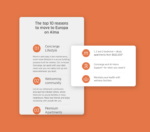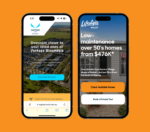BLOG
Navigating Aged Care Marketing: 5 Quick Wins for Better Results
Your customers don’t understand your category names.
When it comes to marketing for aged care and retirement living, there’s a strong push in the sector to use language like “lifestyle village” and “resort-style living.” But let’s be real—is this language your audience types into a search bar? They’re looking for things like “retirement village” or “aged care living,” and industry-preferred terms often get lost in translation.
If you’re looking to attract the right people, then your messaging needs to be clear and aligned with the way those people think. Once you’ve captured their interest, then branded positioning comes into play.
Here are five quick wins to bridge the gap between your marketing and your customers, getting you better results.
1. Align with audience search terms
There’s a digital disconnect between the industry’s spiel for retirement living and the audience’s reality. When it comes to paid Google campaigns, keyword alignment might seem basic, but in aged care marketing, it’s a crucial step often overlooked.
Across many markets, search volumes for “retirement village” far exceed those for “lifestyle village” or similar aspirational language. To meet people where they are, you have to start by speaking their language.
Why this matters
Terms like “retirement village Perth” see around 1,900 searches monthly, compared to just 880 searches for “lifestyle village Perth.” This gap underscores a fundamental truth: people are often looking for functional descriptions of care and living arrangements rather than aspirational ones.
Quick wins
- Do your keyword research: Map out the high-traffic search terms for your location. Words like “aged care living,” “retirement living,” or “over 55s community” often outperform niche terminology. Use this data to anchor your ad copy, content, and landing pages.
- Align ad copy with keywords: Once you’ve identified high-traffic terms, ensure these keywords are reflected in both your ads and on-page content. Consistent messaging across platforms can significantly increase click-through and conversion rates.
- Test and monitor: Test campaigns that use plain-language search terms versus aspirational language to find the best fit for your audience.
Insight: After testing this approach, we saw conversion rate for one of our aged care clients jump from 1.5% to over 4.5% simply by switching to audience-preferred keywords.
2. Elevate your lead capture
One of the most common challenges in aged care marketing is managing lead quality. High-volume lead ad forms may seem convenient, but they often generate enquiries that don’t convert. Why? It’s too easy to fill out a form without fully understanding what’s on offer, leading to leads that don’t match your target. Dedicated lead capture pages offer a way to filter out unqualified leads while keeping engagement high.
Why this matters
Leads generated from quick-form fill-outs often represent an opportunity for nurturing but not necessarily for immediate conversion. By using dedicated landing pages, you’re enabling potential residents or their families to engage with the material in a more intentional way, increasing the likelihood of meaningful enquiries.
Quick wins
- Use targeted lead capture pages: Direct your paid traffic to a channel-specific lead capture page optimised with informative and qualifying content, rather than solely gathering contact details.
- A/B test elements: Experiment with different call-to-action buttons, imagery, and layouts. Testing different layouts or even slight adjustments in wording can make a significant difference in audience behaviour and engagement.
- Streamline your CTAs: Keep your landing pages clean and clear. A single, bold CTA at the top of the page is all you need to guide potential users. Avoid cluttering the page with too many next steps.
Insight: High-performing aged care landing pages focus on an emotional connection above the fold with visuals that reflect community and wellbeing, followed by easy-to-scan icons and value propositions. An effective page layout sets up a strong user journey with a clear value exchange, differentiating your community from competitors.
3. Dial up visual appeal and emotional connection
In the aged care sector, visuals matter. People want to see a lifestyle they can envision for themselves or their loved ones, not just generic images or staged photos. Consider using images and video content that portray real-life moments within your communities, like group activities, resident interactions, or serene outdoor spaces.
Why this matters
Using authentic visuals and emotionally engaging content can build trust and set you apart. We see time and time again that ads with high-quality lifestyle images—featuring real people and daily life—get higher click-through rates and better engagement. You want to reflect the true personality of your community, creating an emotional connection in the visuals that supports the messaging.
Quick wins
- Incorporate branded overlays and icons: Clear visual branding, such as logos and icons, boosts engagement. Pair these elements with lifestyle images and short, impactful messages that highlight unique benefits.
- Utilise video content: Videos like community tours or resident testimonials offer an engaging view that makes your brand feel accessible and authentic.
- Build on consistent brand messaging: Ensure visual branding and messaging across ads align with your website. This reinforces your brand identity and improves ad recall.
Insight: Ads featuring a mix of high-quality interiors, lifestyle images, and branded text overlays have proven successful in our aged care marketing. Quality visuals help create a “picture-in-mind” effect, allowing potential residents to imagine themselves in your community.
4. Refine and simplify your call-to-action (CTA)
Aged care audiences are often in a research mindset rather than a transactional one. With this in mind, crafting a clear, risk-free and focused call-to-action can make a difference. CTAs like “Explore Popular Homes” or “Check Available Homes” resonate more than hard-sell language like “View Properties for Sale.”
Why this matters
Multiple CTA options above the fold can overwhelm users. Simplifying and refining your CTA makes it easier for users to know the next step to take. This approach encourages them to engage further and creates a positive first impression.
Quick wins
- Establish visual hierarchy: Ensure your CTA buttons stand out visually with bold, contrasting colours. Placing a sticky CTA on your page gives users constant access to the next action without forcing them to scroll.
- Craft CTAs for the research mindset: People looking for aged care options are not always ready to buy immediately. Create language that welcomes their exploration and curiosity rather than pressing for an immediate commitment.
Pro tip: Use a larger font size and a unique colour for your primary CTA, ensuring it stands out without competing with other elements on the page.
5. Sync up your ad copy and landing pages
Consistency is key. There’s no quicker way to lose a user’s interest than failing to deliver what was promised in the ad. If your ad says “Aged Care Living in Melbourne” then your landing page should echo that promise rather than unrelated or overly stylised messaging.
Why this matters
When ad copy doesn’t match the landing page, users feel misled. They expect a consistent experience, from first click to the final page they land on. Ensuring your ad and landing page align in messaging, visuals, and tone fosters trust and helps users understand they’re in the right place.
Quick wins
- Mirror your ad copy on the landing page: Avoid jargon and make sure the language in your ad copy is carried over to the landing page. For paid Google campaigns, reinforce the search terms.
- Highlight location and community names: Many users look for options in specific regions, so make sure location qualifiers are front and centre in both your ad and on the landing page.
- Feature value props consistently: If your ad focuses on amenities or community features, such as social spaces or health facilities, make sure these elements appear in detail. That continuity helps potential residents get a clear sense of the community.
Bringing it all together
The world of aged care marketing is evolving. It’s not enough to rely on industry jargon or traditional approaches. By embracing straightforward, high-traffic search terms, optimising lead capture, creating relatable visuals, refining CTAs, and ensuring ad-to-page consistency, aged care providers can dramatically improve their outreach and connection with their target audience.
These quick wins aren’t just minor tweaks—they’re a way to close the gap between your marketing strategy and the people looking for your product. Remember, the goal is to meet people where they are, using language and visuals they understand and trust. The result? Better engagement, more conversions and, ultimately, a more resonant brand in the aged care and retirement living space.















